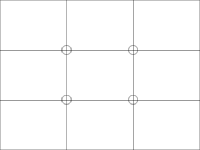Since my other hobby is photography, I already know some things about this topic.
- Landscape pictures should have a foreground, a midground and a background.
- The rule of thirds say that the main focal point should not placed in the middle as many do, but at the instersection of the lines shown in the pic here.

The rule of thirds also suggest the horizon line to be along one of the lines and not be in the middle of the image.
- Avoid competing focal points.
- Balance the picture, in other words not to have more stuff on one side than the other.
- Objects in motion needs much space in front of the moving direction.
- It's good to direct the wandering of the eyes around the picture, make the viewer spend some time in it, and that the first path should lead to the main object of interest. And that s-shaped paths are better than straight.
- Objects should not share edges.
These are some rules I follow when taking photos, all these applies to paintings too, but since there are more control when painting other rules apply too.
- Break up big surfaces (with shadow, reflection, light, textures, imperfections etc.)
- Get the perspective right (usually two point perspective).
- Use values for depth. Objects closer should be darker and contrastier and further away should be lighter and more washed out.
- Choose a main hue for the painting, but add other hues for variation (analogous, complements or triads).
- Vary the shapes. A painting with many square shapes (f.ex. buildings) should be balanced with rounder shapes (f.ex. clouds).
Here are more rules:
Landscape Composition RulesThe Basics of Landscape CompositionComposition: Understanding it - Using it!Rule of Thirds





 The rule of thirds also suggest the horizon line to be along one of the lines and not be in the middle of the image.
The rule of thirds also suggest the horizon line to be along one of the lines and not be in the middle of the image.